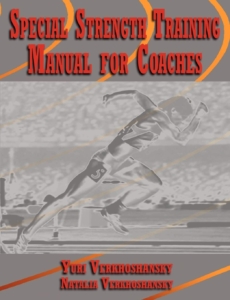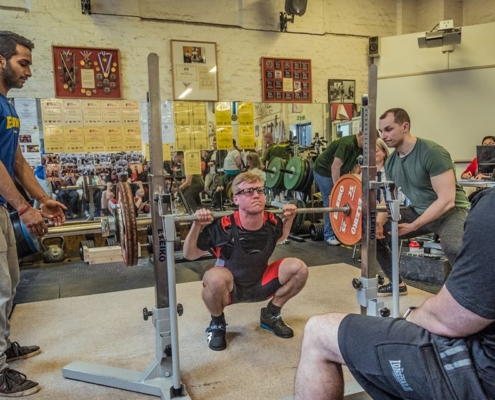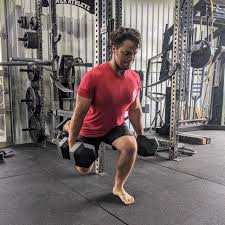Russian Special Strength Training (SST) – Part 2
This is the last blog post to round off my series on ”Power” development as it relates to jumping. There will definitely be a follow up on other concepts such as rotational power and upper body power, but I’ll save that for another day.
Special Strength Training Manual for Coaches – Vuri & Natalia Verkhoshansky (2011) has been a go to text for me over the years, and each time I read it I take another gem away. It’s certainly not an easy read, even with the good translation it’s still written in a pretty complex writing style so it can be hard to get through in parts.
In this Part 2 I will look at combined methods of Special strength training (SST). Please take a look at Part 1 for more info on the Loading schemes recommended.
Combined Methods used in SST
The ultimate goal is to increase the level of maximal explosive force effort of similar movements using highly specific explosive strength exercises (jumps). Before the use of these highly specific explosive strength exercises, it is necessary to enforce the main muscle synergies (coordination), which ensure improvements in the CAPACITY TO OPPOSE THE FORCE OF GRAVITY: barbell squats, standing calf raises and more specifically, the seated calf raise.
Chapter 4 of the book features further information on the combined methods of SST which consist of combinations of different SST means in order to ensure a determined cumulative training effect. I will also refer back to Chapter 2 where Yuri talks about Isometric exercises (pg 81) and then gives examples of Combined Regimes (pg 83-85).
Depending on what means are used, how they are performed, and how they are temporarily combined, it is possible to differentiate the following Combined Methods:
- Complex Method
- Stimulation Method
- Contrast Method
- Circuit Method
- Strength-Aerobic Method
I will check back through the Triphasic Method book as I know that the use of the terms ”complexes” and ”contrasts” can mean different things to different coaches, but for the purposes of this blog the use of the word complex and contrast will be as used in the Book chapters, and according to their descriptions below.
For this blog I will focus on the first two: Complex Method and Stimulation Method.
Complex Method
”The Complex Method consists of a combination of SST means having the same primary emphasis but different characteristics of their training effect.”
The important point here is that different means can be used not only in the same training session, but also in conjunction with other training sessions in adjoined training sessions.
In Chapter 2 Yuri gives examples of research study (Lelikov experiment) which showed that a complex method using dynamic resistance exercises with different movement speeds were carried out (combined in equal proportion- presumably over the course of the week) to increase Maximal Strength to a greater degree than the training groups that only trained at one movement speed. The movement rates were high, low, middle rates or combined).
He also described the experiment of B. Pletnev who showed that the 4th group who performed a complex method using resistance exercises in overcoming, yielding and isometric regimes, combined in equal proportion, reached the highest increase in Maximal strength in comparison with the results reached by the other three groups. which performed the same exercises, only in overcoming, yielding and isometric regimes.
Therefore it is possible to assert that the Complex Method utilises the body’s capacity to utilise the adaptive reactions of different training stimuli in the resultant training effect, which is greater than the sum of the training effects of each exercise. This means you mean that the result is better than you would expect from the individual parts, because the way they combine adds a different quality.
Another example could be combining in the same week the Refusal Method (essentially doing moderate reps to failure- think 10 reps at a 10 RM) and the Circuit Method (think 10 reps – not to failure- but with only short rest between exercises of say 30 -seconds to work in an aerobic and muscular endurance regime).
The results were better with a group of cross-country skiers who combined the methods rather than only doing the Refusal Method or the Circuit Method.
Finally, this could also include combinations of similar means with similar training directions such as:
- Barbell Squat Jumps with Kettlebell Squat Jumps
- Depth jumps from different heights;
- Jump exercises with a take-off on one or both legs
- Short bounds and long bounds
Stimulation Method
”The Stimulation Method can be illustrated by an experiment conducted by V. Nedobivailo. Three groups of athletes used three different resistance training programmes aimed at increasing the power output in the vertical jump.”
- the first group carried out slow Barbell squats with a weight equal to 90% of 1 RM
- the second group carried out Barbell Vertical Jumps with a weight equal to 50% of 1 RM
- the third group carried out a combination of the two exercises used by the 1st and 2nd group; in the SAME TRAINING SESSION with the following sequence 1) slow movements with a weight of 90% 1 RM 2) Barbell Vertical Jumps with a weight of 50% of 1 RM
The highest increase in power output was obtained by the third group (20%), compared to 8% for group 1 and 15% for group 2.
In a classic experiment (which I believe was reproduced many times over with Western researchers) it was shown that executing the Barbell squat ensures a notable increase around 6% (and up to 7.8%) in the subsequent vertical jump height if the time interval is between 3 and 6 minutes, with 4 minutes being optimum.
”These experiments concluded that the Stimulation Method maximises the training effect of a speed-strength exercise using a CNS stimulating effect produced by the previous tonic exercise.”
Usually resistance exercises are used as tonic (stimulating) exercises executed via the Maximal Effort Method (see part 1 for more info). If the athlete is still not able to execute the Barbell Squat using the Maximal Effort Method, he may use the Kettlebell Squat Jump as a tonic exercise.
Increasing Explosive Strength in the take-off movements, for example (jump force), five combinations of two exercises are listed below. These variants of the Stimulation Method have different training potentials, increasing from variant 1 to variant 5. Only one of these variants may be used in a training session.
Combination Method – Explosive Strength
| Stimulation Method Variant | First Exercise | Rest between exercises | Second Exercise | Number of sets of combination | Rest between sets |
| 1 | Kettlebell Squat jumps
Weight = 6-24 kg 2 sets of 6-8 jumps Rest between sets 3-4 min |
3-4 min | Leg to Leg bounce
6-8 take offs 2 sets of 5-6 bounces Rest between sets 3-4 min |
2-3 | 6-8 min |
| 2 | Barbell Squat
Weight = 70-80% 2 sets of 5-6 reps
Rest between sets 2-4 min |
4-6 min | Standing Triple Jump
2-3 sets of 6-8 jumps Rest between sets 4-6 min |
2-3 | 6-8 min |
| 3 | Barbell Squat
Weight = 80-85% 2 sets of 2-3 reps
Rest between sets 3-4 min |
4-6 min | Kettlebell Squat jumps
Weight = 16-32 kg 2-3 sets of 4-6 jumps Rest between sets 3-4 min |
2-3 | 6-8 min |
| 4 | Barbell Squat
Weight = 90% 2 sets of 2-3 reps
Rest between sets 3-4 min |
4-6 min | Vertical Jump with Barbell
Weight = 30% 3 sets of 6-8 jumps
Rest between sets 3-4 min |
2-3 | 8-10 min |
| 5 | Barbell Squat
Weight = 90-95% 2 sets of 2 reps
Rest between sets 2-4 min |
4-6 min | Depth Jump
Height = 0.75 m 2 sets of 6-8 jumps
Rest between sets 4-6 min |
2-3 | 8-10 min |
A Word on Isometrics
One other option is to use ISOMETRIC EXERCISES which may also be used as a tonic exercise.
- pushing against an immobilized object
- holding a weight in a fixed position
The second variant of isometric tension is very effective when it is performed with a forced lengthening of the contracted muscles.
Exercises are performed involving isometric tensions lasting from 6 to 8 seconds of 2-3 reps holding a weight equal to 80% of maximal paired with an explosive strength exercise of 4-6 reps with a weight of 40-60% of maximal.
Isometrics grew in popularity in the 1950 s after T. Hettinger and E. Muller (1953, 1955) established that 10 weeks of daily execution of isometric tension at 2/3 of the maximum level for a length of 6 seconds, leads to a weekly increase of 5% in muscular strength.
Isometric training can be more effective than dynamic training particularly for those sport disciplines in which the external opposition in the competition exercise is high.
In sports that require high speed movements against low external opposition, isometric training is less effective than dynamic training. The use of isometrics leads to increases in muscle stiffness, that is, decreases the muscle’s elasticity (flexibility). This is why in disciplines involving high velocity dynamic muscle work, prolonged use of isometric overloads is not suitable.
Whats more, isometric exercises provide better visual and kinesthetic memorization of movement images than the dynamic regime of muscular work. This is why the isometric method is very useful in teaching and correcting mistakes.
There are two types of isometric regimes:
- Explosive Strength Regime
- Non Explosive Isometric Regime
Explosive Strength Regime
This isometric muscular contraction has an explosive character; it is carried out by emphasising the speed of tension developed up to a maximum of 80-90%. This ensures the development of Explosive and Starting Strength (aka Ballistic strength #APAMETHOD). Duration of isometric is typically 3-8 seconds.
Non- Explosive Strength Regime
This isometric muscular contraction is performed in order to achieve a given magnitude of strength effort without time limits and maintaining the level of tension as long as possible. This promotes the development of Maximal Strength and Static Strength Endurance. Duration of isometric is typically 20-30 seconds.
In non explosive isometric exercises, it is necessary to:
- gradually develop the strength engagement applied to a motionless object
- use 5-10 seconds rest between repetitions
- limit the duration of isometric training to 10 minutes per workout
- finish the isometric training with relaxation exercises
The problem with isometric exercises is that the magnitude of the strength effort can only be determined subjectively. To solve this problem, non explosive isometric exercises should be executed holding a determined weight for a given period of time.
Quasi-Isometric Regime
Another solution is to use the combined regime (QUASI-ISOMETRIC) which involves lifting of a weight (dynamic strength effort) and then pushing or holding the weight for a given period of time (static strength effort).
Pushing Version
The pushing version of the quasi-isometric exercise is known as Hoffmann’s method. It consists of lifting the weight, followed by a push against a permanent support with an isometric contraction (think- doing a back squat to raise the weight before pushing up against the safety squat pins, and push against it to create the isometric tension.
The overload can be lifted more than once in the space before the pins (although the pins would need to be placed higher than in the photo above), and after completing the last lift, an isometric tension can be used for as long as required.
Holding Version
The holding version of the quasi-isometric exercise consists of lifting a heavy weight a long trajectory (such as a Clean from the floor to start of the second pull), with stops of 5-6 seconds of isometric tension, such as at the end of the first pull and also at the start of the second pull.
Raise the weight slowly along the vertical trajectory, interrupting the movement at set intervals of the range of motion. This allows tension to act on the muscles along the whole trajectory and to assess the strength increase based on the increases in the overload.
Combination Method- High Speed Strength
| Stimulation Method Variant | First Exercise | Rest between exercises | Second Exercise | Number of sets of combination | Rest between sets |
| 1 | Barbell Squat
Weight = 50-75% 2 sets of 3-4 reps
Rest between sets 3-4 min |
4-6 min | Barbell Squat
Weight = 30% 3 sets of 6-8 jumps
Rest between sets 3-4 min |
2-3 | 8-10 min |
| 2 | Barbell Squat
Weight = 50-70% 2 sets of 3-4 reps
Rest between sets 3-4 min |
4-6 min | Barbell Squat
Weight = 15% 2-3 sets of 8-10 jumps
Rest between sets 3-4 min |
2-3 | 8-10 min |
For Variant 1 the 30% 1 RM is performed with maximum speed and muscular relaxation between repetitions.
For Variant 2 the 15% 1 RM is performed either by increasing the speed of movement in the overcoming phase with moderate yielding tempo and relaxation between sets, or by increasing the frequency of movements with maximum tempo.
For further info on the Explosive and High speed strength (aka Ballistic Strength) protocols you may also want to read the blogs on Triphasic Method and the training mesocycles for Power and Speed.
Considerations For Use
Since the Stimulation Method has a very strong effect on the body, especially on the musculo-skeletal system, close attention must be paid to its use in training. More specifically:
- To apply the Stimulation Method, it is necessary to prepare the leg muscles by using barbell and jump exercises during the PRECEDING training stage.
- The training effect of the Stimulation Method is reduced considerably if it is carried out while fatigued
- Since the Stimulation Method utilises much energy, it should not be used before a workout which requires precise coordination of effort, high movement speed, and display of Explosive Strength or endurance.
Hope you have found this article useful. Stand by for the final installment Part 3 of this SST series where we look at the Contrast Method, Circuit Method and Strength-Aerobic Method.
Remember:
- If you’re not subscribed yet, click here to get free email updates, so we can stay in touch.
- Share this post using the buttons on the top and bottom of the post. As one of this blog’s first readers, I’m not just hoping you’ll tell your friends about it. I’m counting on it.
- Leave a comment, telling me where you’re struggling and how I can help
Since you’re here…
…we have a small favor to ask. APA aim to bring you compelling content from the world of sports science and coaching. We are devoted to making athletes fitter, faster and stronger so they can excel in sport. Please take a moment to share the articles on social media, engage the authors with questions and comments below, and link to articles when appropriate if you have a blog or participate on forums of related topics. — APA TEAM










